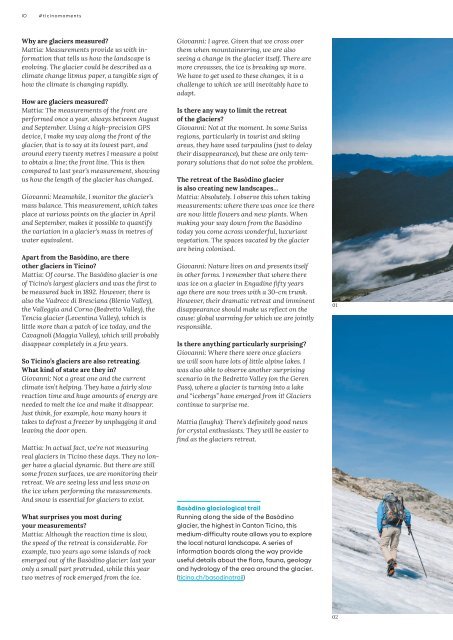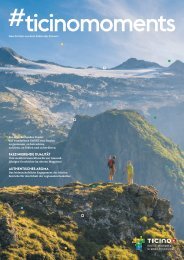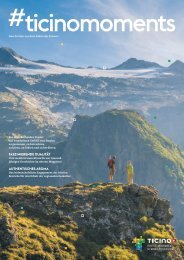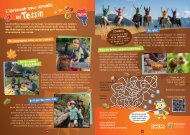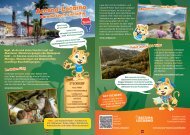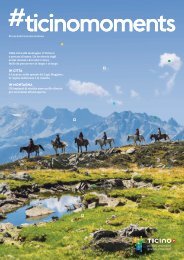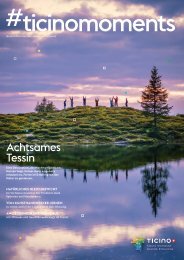#ticinomoments 2024
- No tags were found...
Create successful ePaper yourself
Turn your PDF publications into a flip-book with our unique Google optimized e-Paper software.
10 <strong>#ticinomoments</strong><br />
Why are glaciers measured?<br />
Mattia: Measurements provide us with information<br />
that tells us how the landscape is<br />
evolving. The glacier could be described as a<br />
climate change litmus paper, a tangible sign of<br />
how the climate is changing rapidly.<br />
How are glaciers measured?<br />
Mattia: The measurements of the front are<br />
performed once a year, always between August<br />
and September. Using a high-precision GPS<br />
device, I make my way along the front of the<br />
glacier, that is to say at its lowest part, and<br />
around every twenty metres I measure a point<br />
to obtain a line; the front line. This is then<br />
compared to last year’s measurement, showing<br />
us how the length of the glacier has changed.<br />
Giovanni: Meanwhile, I monitor the glacier’s<br />
mass balance. This measurement, which takes<br />
place at various points on the glacier in April<br />
and September, makes it possible to quantify<br />
the variation in a glacier’s mass in metres of<br />
water equivalent.<br />
Apart from the Basòdino, are there<br />
other glaciers in Ticino?<br />
Mattia: Of course. The Basòdino glacier is one<br />
of Ticino’s largest glaciers and was the first to<br />
be measured back in 1892. However, there is<br />
also the Vadrecc di Bresciana (Blenio Valley),<br />
the Valleggia and Corno (Bedretto Valley), the<br />
Tencia glacier (Leventina Valley), which is<br />
little more than a patch of ice today, and the<br />
Cavagnoli (Maggia Valley), which will probably<br />
disappear completely in a few years.<br />
So Ticino’s glaciers are also retreating.<br />
What kind of state are they in?<br />
Giovanni: Not a great one and the current<br />
climate isn’t helping. They have a fairly slow<br />
reaction time and huge amounts of energy are<br />
needed to melt the ice and make it disappear.<br />
Just think, for example, how many hours it<br />
takes to defrost a freezer by unplugging it and<br />
leaving the door open.<br />
Mattia: In actual fact, we’re not measuring<br />
real glaciers in Ticino these days. They no longer<br />
have a glacial dynamic. But there are still<br />
some frozen surfaces, we are monitoring their<br />
retreat. We are seeing less and less snow on<br />
the ice when performing the measurements.<br />
And snow is essential for glaciers to exist.<br />
What surprises you most during<br />
your measurements?<br />
Mattia: Although the reaction time is slow,<br />
the speed of the retreat is considerable. For<br />
example, two years ago some islands of rock<br />
emerged out of the Basòdino glacier: last year<br />
only a small part protruded, while this year<br />
two metres of rock emerged from the ice.<br />
Giovanni: I agree. Given that we cross over<br />
them when mountaineering, we are also<br />
seeing a change in the glacier itself. There are<br />
more crevasses, the ice is breaking up more.<br />
We have to get used to these changes, it is a<br />
challenge to which we will inevitably have to<br />
adapt.<br />
Is there any way to limit the retreat<br />
of the glaciers?<br />
Giovanni: Not at the moment. In some Swiss<br />
regions, particularly in tourist and skiing<br />
areas, they have used tarpaulins (just to delay<br />
their disappearance), but these are only temporary<br />
solutions that do not solve the problem.<br />
The retreat of the Basòdino glacier<br />
is also creating new landscapes…<br />
Mattia: Absolutely. I observe this when taking<br />
measurements: where there was once ice there<br />
are now little flowers and new plants. When<br />
making your way down from the Basòdino<br />
today you come across wonderful, luxuriant<br />
vegetation. The spaces vacated by the glacier<br />
are being colonised.<br />
Giovanni: Nature lives on and presents itself<br />
in other forms. I remember that where there<br />
was ice on a glacier in Engadine fifty years<br />
ago there are now trees with a 30-cm trunk.<br />
However, their dramatic retreat and imminent<br />
disappearance should make us reflect on the<br />
cause: global warming for which we are jointly<br />
responsible.<br />
Is there anything particularly surprising?<br />
Giovanni: Where there were once glaciers<br />
we will soon have lots of little alpine lakes. I<br />
was also able to observe another surprising<br />
scenario in the Bedretto Valley (on the Geren<br />
Pass), where a glacier is turning into a lake<br />
and “icebergs” have emerged from it! Glaciers<br />
continue to surprise me.<br />
Mattia (laughs): There’s definitely good news<br />
for crystal enthusiasts. They will be easier to<br />
find as the glaciers retreat.<br />
Basòdino glaciological trail<br />
Running along the side of the Basòdino<br />
glacier, the highest in Canton Ticino, this<br />
medium-difficulty route allows you to explore<br />
the local natural landscape. A series of<br />
information boards along the way provide<br />
useful details about the flora, fauna, geology<br />
and hydrology of the area around the glacier.<br />
(ticino.ch/basodinotrail)<br />
01<br />
02


